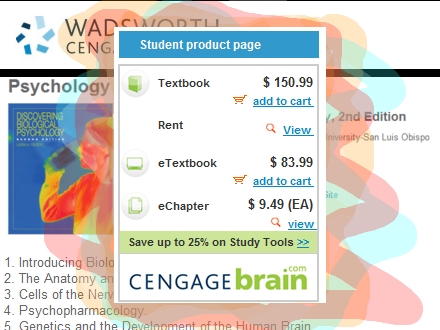It’s an exciting time indeed to be a textbook author. I’m taking a break from translating my most recent intro work into a pdf document for reviewers–it’s a fair amount of work, but I think the reviewers’ job is easier when the don’t have to wade through a Word document with all the captions, features, and images lumped at the end. Plus, I get to play creative by placing a photo just so….it’s actually fun.
In the meantime, I think that publishers are doing a great job now of getting materials into student hands at reduced costs. As you can see from the image below, my bio book is available in several formats. Students seem to really like the rental option, but my favorite is the eBooks. At first, I wasn’t too keen on the idea of reading on a computer screen, but was won over by a student who pointed out you can SEARCH using the eBook. Wow. How that would have changed my student life! The eBook comes with the study guide materials included, too, which is a big savings.
I’m hoping to ask a quick clicker question this week (our third of the quarter) to see what students have opted to do about books. Should be interesting!
Of course, the big boys (aka the commercial booksellers) are already in threat mode about the publishers providing direct sales to students. I read recently that one big chain was offering more textbooks for rent, too. They must be scared. The big difference is that when you rent or buy from the publisher directly, you’re actually helping to keep textbook costs down, but when you rent or buy from a campus bookstore or other retail chain, you’re making books more expensive. When the big boy retailers recycle our work, they don’t pay us a dime, which means that we have to pay the artists, editors, indexers, photo researchers, and all the other people who contribute to the work by charging more for new books. I don’t think the chain prices are much less, either, in spite of the fact that they’re getting all of our hard work for free.
So between you and me? I’d choose the publisher direct option. It’s only fair, and in the long run, it’s the only way to make the cost of books come down. Nobody resells Harry Potter, which costs about $20 because the publisher can spread all costs across all users. The more people who use chain stores for textbooks, the fewer actually support the costs of production, and books have to be more expensive.



2 Comments
laurenshaber · February 3, 2010 at 9:29 am
As a student who has used both hard copies of textbooks and e-versions of textbooks, I definitely prefer the hard copy. Though it may be easier to search through an e-book, it is actually more convenient for me, personally, to flip to the index and search that way. I find it easier to get distracted when on a computer compared to when reading a hard copy version. Plus, I like being able to highlight and write my own notes in the margin. Maybe I prefer being “old fashioned,” but I will always lean toward using hard copies of textbooks.
Leslie Ryan · February 15, 2010 at 7:55 pm
I’m with Lauren. I do prefer a hard copy. I do have one e-book right now. I can print out pages if I want to, but that runs up the cost using printer ink. Printing in draft mode does help.
I can easily imagine having an e-book of some of my textbooks instead of a hard copy. I have 3 books this quarter that I could probably have gotten by with an ebook. Unfortunately, I didn’t know that until I’d bought the books and I’m not sure ebooks were offered as an option.
I recently posted a comment on an article in our local paper. The article was about our University bookstore’s plan to start renting books. I explained why the price of textbooks was so high and that authors don’t get a dime of loyalties when a book is resold at a bookstore. Publishers and authors musy recoup there costs and make their “dime” on the initial sale of the book.
I am thinking that learning to live with ebooks would be wise.
Comments are closed.